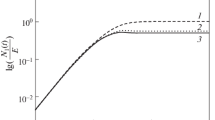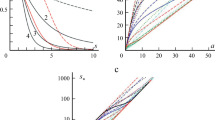Abstract
A model of viscoelastic material, whose elastic and dissipative potentials are build on a microscopic restructuring, is proposed. The continuum body is viewed as a collection of ‘elementary structures’ whose borders’ deformation is governed by the gradient of deformation F. Each elementary structure is constituted of a central cell floating in a viscous matrix to mimic, in a simple way, the micro-structure of biological tissues. The application of an external load leads to the restructuring of the inner geometry of the elementary structure by stretching or contracting the fibers present in cell and in matrix, and by running the flow of the viscous fluid around the central cell. Simulations are restricted to the two-dimensionnal unidirectional traction test. In this case, the inner configuration of the elementary structure is completely characterized by one size length of the cell, let say c 1. The law governing the time evolution of the internal variable c 1 is determined solving an ordinary differential equation, resulting from the compensation between elastic and viscous forces within the elementary structure f(c1+g(c1,c1)=0), where f derives from the elastic potential, and g derives from the dissipative potential. The time dependence is transmitted to the macroscopic behaviour of material. A simulation test applying an instantaneous strain is done and the relaxation properties of the material are discussed.

Traction test and material microstructure.

Response of the microstructure to an instantaneous strain loading.

Response of the macro-stress to an instantaneous strain loading (relaxation phenomenon).
Access this chapter
Tax calculation will be finalised at checkout
Purchases are for personal use only
Similar content being viewed by others
References
M. Holeček, F. Moravec, Hyperelastic model of a material whose microstructure is formed by “balls and springs”, in submission to the International Journal of Solids and Structures.
D.P. Pioletti, L.R. Rakotomanna (2000), Non-Linear viscoelastic laws for soft biological tissues, Eur. J. Mech. A/Solids 19, 749–759
Author information
Authors and Affiliations
Editor information
Editors and Affiliations
Rights and permissions
Copyright information
© 2006 Springer
About this paper
Cite this paper
Moravec, F., Müller, M. (2006). Microstructural model of the viscoelastic behaviour of biological tissues. In: Motasoares, C.A., et al. III European Conference on Computational Mechanics. Springer, Dordrecht. https://doi.org/10.1007/1-4020-5370-3_596
Download citation
DOI: https://doi.org/10.1007/1-4020-5370-3_596
Publisher Name: Springer, Dordrecht
Print ISBN: 978-1-4020-4994-1
Online ISBN: 978-1-4020-5370-2
eBook Packages: EngineeringEngineering (R0)




